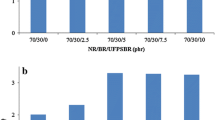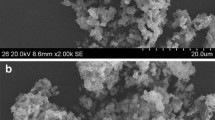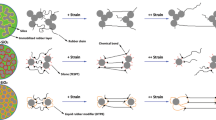Abstract
A novel molecular model of vulcanized styrene-butadiene rubber (SBR) was developed and experimentally verified to elucidate the enhanced tribological performance of vulcanized SBR over raw SBR. Vulcanization was modeled by cross- or self-linkages of sulfur (S) atoms with carbon (C) atoms in molecular chains. Frictional models were developed for vulcanized and raw styrene-butadiene rubber-ferrum (SBR-Fe) to study the atomic behavior at the frictional interface. The results at the atomic scale show considerable reductions in the coefficient of friction (COF) and the interfacial temperature of approximately 45.8% and 13.27% for the vulcanized SBR matrix, respectively, from those of raw SBR. In addition, the relative concentration (RC), the radial distribution function (RDF) and interaction energy of the vulcanized SBR are 21.61%, 6.68% and 60.12% lower than those of the raw SBR, respectively. The resulting decrease in the real contact area, adhesion and contact temperature at the interface can significantly improve the tribological properties of the vulcanized SBR over those of raw SBR. The results of this research study show how vulcanization can enhance the tribological properties of polymer composites at the atomic scale.
Graphical Abstract












Similar content being viewed by others
References
Natarajan, S.: Fundamental Principles of Polymeric Materials by Christopher S. Brazel and Stephen L. Rosen. Mater. Manuf. Process. 30, 1510–1511 (2015)
Lorenz, B., Persson, B.N.J., Fortunato, G., Giustiniano, M., Baldoni, F.: Rubber friction for tire tread compound on road surfaces. J. Phys.-Condes. Matter. 25, 095007 (2013)
Kruelák, J., Sykora, R., Hudec, I.: Sulphur and peroxide vulcanization of rubber compounds - overview. Chem. Pap. 70, 1533–1555 (2016)
Vulcanization. https://www.britannica.com/technology/vulcanization
Roberts, A.D., Jackson, S.A.: Sliding friction of rubber. Nature 257, 118–120 (1975)
Barquins, M., Roberts, A.D.: Rubber friction variation with rate and temperature: some new observations. J. Phys. D. Appl. Phys. 19(133), 1013–1026 (1986)
Duering, E.R., Kremer, K., Grest, G.S.: Relaxation of randomly cross-linked polymer melts. Phys. Rev. Lett. 67, 3531–3534 (1991)
Duering, E.R., Kremer, K., Grest, G.S.: Structure and relaxation of end-linked polymer networks. J. Phys. Chem. 101, 8169–8192 (1994)
Barsky, S.J., Plischke, M.: Order and localization in randomly cross-linked polymer networks. Phys. Rev. E. 53, 871–876 (1996)
Barsky, S.J., Plischke, M., Joós, B., Zhou, Z.C.: Elastic properties of randomly cross-linked polymers. Phys. Rev. E. 54, 5370–5376 (1996)
Plischke, M., Barsky, S.J.: Molecular dynamics study of the vulcanization transition. Phys. Rev. E. 58, 3347–3352 (1998)
Barsky, S., Plischke, M.: Molecular dynamics study of replica symmetry in the vulcanization transition. Phys. Rev. E. 60, 4528–4533 (1999)
Bergström, J.S., Boyce, M.C.: Deformation of elastomeric networks: relation between molecular level deformation and classical statistical mechanics models of rubber elasticity. Macromolecules 34, 614–626 (2001)
Oberdisse, J., Ianniruberto, G., Greco, F., Marrucci, G.: Mechanical properties of end-crosslinked entangled polymer networks using sliplink Brownian dynamics simulations. Rheol. Acta. 46, 95–109 (2006)
Koga, T., Tanaka, F.: Elastic properties of polymer networks with sliding junctions. Eur. Phys. J. E. 17, 225–229 (2005)
Bhawe, D.M., Cohen, C., Escobedo, F.A.: Effect of chain stiffness and entanglements on the elastic behavior of end-linked elastomers. J. Phys. Chem. 123, 014909 (2005)
Rigby, D., Sun, H., Eichinger, B.E.: Computer simulations of poly(ethylene oxide): force field, pvt diagram and cyclization behaviour. Polym. Int. 44, 311–330 (1997)
Sun, H.: COMPASS: An ab Initio Force-Field Optimized for Condensed-Phase Applications- Overview with Details on Alkane and Benzene Compounds. J. Phys. Chem. B. 102, 7338–7364 (1998)
Yin, B., Peng, Z.J., Liang, J., Jin, K., Zhu, S., Yang, J., Qiao, Z.H.: Tribological behavior and mechanism of self-lubricating wear-resistant composite coatings fabricated by one-step plasma electrolytic oxidation. Tribol. Int. 97, 97–107 (2016)
Pan, D., Fan, B.I., Qi, X.W., Yang, Y.L., Hao, X.H.: Investigation of PTFE tribological properties using molecular dynamics simulation. Tribol. Lett. 67, 28 (2019)
Osei-Agyemang, E., Berkebile, S., Martini, A.: Decomposition mechanisms of anti-wear lubricant additive tricresyl phosphate on iron surfaces using DFT and atomistic thermodynamic studies. Tribol. Lett. 66, 48 (2018)
Duan, C.J., Yang, Z.H., Zhang, D., Tao, L.M., Wang, Q.H., Wang, T.M.: Effect of isomerism on mechanical and tribological properties of thermoplastic polyimide films. Tribol. Int. 121, 373–380 (2018)
Jin, Y.L., Duan, H.T., Cheng, B.X., Wei, L., Tu, J.S.: Synthesis of a Multi-phenol Antioxidant and Its Compatibility with Alkyl Diphenylamine and ZDDP in Ester Oil. Tribol. Lett. 67, 58 (2019)
Song, J.F., Zhao, G.: A molecular dynamics study on water lubrication of PTFE sliding against copper. Tribol. Int. 136, 234–239 (2019)
Li, Y.L., Wang, S.J., Arash, B., Wang, Q.: A study on tribology of nitrile-butadiene rubber composites by incorporation of carbon nanotubes: Molecular dynamics simulations. Carbon 100, 145–150 (2016)
Song, J.F., Lei, H., Zhao, G.: Improved mechanical and tribological properties of polytetrafluoroethylene reinforced by carbon nanotubes: A molecular dynamics study. Comput. Mater. Sci. 168, 131–136 (2019)
Li, Y.L., Wang, S.J., Wang, Q.: A molecular dynamics simulation study on enhancement of mechanical and tribological properties of polymer composites by introduction of graphene. Carbon 111, 538–545 (2017)
Luo, Y.L., Wu, Y.P., Luo, K.Q., Cai, F., Zhai, T.S., Wu, S.Z.: Structures and properties of alkanethiol-modified graphene oxide/solution -polymerized styrene butadiene rubber composites: Click chemistry and molecular dynamics simulation. Compos. Sci. Technol. 161, 32–38 (2018)
Li, Y.L., Wang, S.J., Wang, Q., Xing, M.: Molecular dynamics simulations of tribology properties of NBR (Nitrile-Butadiene Rubber) /carbon nanotube composites. Compos. Pt. B-Eng. 97, 62–67 (2016)
Li, Y., Wu, Y.P., Luo, Y.L., Chan, T.W., Zhang, L.Q., Wu, S.Z.: A combined experimental and molecular dynamics simulation study on the structures and properties of three types of styrene butadiene rubber. Mater. Today Commun. 4, 35–41 (2015)
Hou, Y., Zhang, H.F., Wu, J.F., Wang, L.B.: Study on the microscopic friction between tire and asphalt pavement based on molecular dynamics simulation. International Journal of Pavement Research and Technology. 11, 205–212 (2018)
Chawla, R., Sharma, S.: A molecular dynamics study on Young’s modulus and tribology of carbon nanotube reinforced styrene-butadiene rubber. J. Mol. Model. 24, 96 (2018)
Hoover, W.G.: Canonical dynamics: equilibrium phase-space distributions. Phys. Rev. A. 31, 1695–1697 (1985)
Nosé, S.: A Molecular-dynamics method for simulations in the canonical ensemble. Mol. Phys. 52, 255–268 (1984)
Berendsen, H.J.C., Postma, J.P.M., Van Gunsteren, W.F., DiNola, A., Haak, J.R.: Molecular dynamics with coupling to an external bath. J. Chem. Phys. 81, 3684–3690 (1984)
Petronela, D., Nergis, B., Cimpoesu, N., Vizureanu, P., Baciu, C., Bejinariu, C.: Tribological characterization of phosphate conversion coating and rubber paint coating deposited on carbon steel carabiners surfaces. Mater. Today: Proc. 19, 969–978 (2019)
Moreno-Ríos, M., Gallardo-Hernández, E.A., Yáñez-Escoto, M.J., Márquez-Tamayo, L.A., Iturbe-Salas, E.: Evaluation of surface modification in a steel track for the rubber tyred Metro. Wear 426–427, 1265–1271 (2019)
Ismailov, A., Järveläinen, M., Levänen, E.: Problematics of friction in a high-speed rubber-wheel wear test system: A case study of irregularly rough steel in water lubricated contact. Wear 408–409, 65–71 (2018)
Setiyana, B., Jamari, J., Sugiyanto, J.S.: Stress analysis of the friction contact on filled styrene butadiene rubber by a blade indentation: a numerical investigation. Mater. Today: Proc. 13(1), 293–298 (2019)
Accelrys Software Inc. Materials Studio Release Notes, Release 7.0, San Diego: Accelrys Software Inc. 2013.
Droste, D.H., Dibenedetto, A.T.: The glass transition temperature of filled polymers and its effect on their physical properties. J. Appl. Polym. Sci. 13, 2149–2168 (1969)
Eslami, H., Müller-Plathe, F.: Structure and mobility of poly(ethylene terephthalate): a molecular dynamics simulation study. Macromolecules 42, 8241–8250 (2009)
Dong, J., Song, T.J., Cui, Y., Zhang, H.Q., Hu, C.Z., Tao, H.P.: Synthesis and dynamic mechanical properties of solution polymerized butadiene-styrene. China Elastomerics. 20, 30–33 (2010)
Sasaki, T., Uchida, T., Sakurai, K.: Effect of crosslink on the characteristic length of glass transition of network polymers. J. Polym. Sci. Part B: Polym. Phys. 44, 1958–1966 (2006)
Alves, N.M., Gómez Ribelles, J.L., Mano, J.F.: Enthalpy relaxation studies in polymethyl methacrylate networks with different crosslinking degrees. Polymer 46, 491–504 (2005)
Grosch, K.A.: The Speed and Temperature Dependence of Rubber Friction and Its Bearing on the Skid Resistance of Tires. The Physics of Tire Traction, Springer, US (1974)
Persson, B.N.J., Tosatti, E.: Qualitative theory of rubber friction and wear. J. Chem. Phys. 112, 2021–2029 (2000)
Savio, D., Fillot, N., Vergne, P., Zaccheddu, M.: A model for wall slip prediction of confined n-alkanes: Effect of wall fluid interaction versus fluid resistance. Tribol Lett 46(1), 11–22 (2012)
Hammerschmidt, J.A., Gladfelter, W.L., Haugstad, G.: Probing Polymer Viscoelastic Relaxations with Temperature-Controlled Friction Force Microscopy. Macromolecules 32, 3360–3367 (1999)
Sosnovskii, L.A.: Statistical model for a deformable solid with a critical volume and some of its applications. Communication 3. Strength Mater. 24, 646–653 (1992)
Acknowledgements
We acknowledge financial support for this study from the National Natural Science Foundation of China (Grant No. 51975300) and the Foundation of the State Key Laboratory of Automotive Simulation and Control (Grant No. 20171112). This research study was also partially supported by a grant from the K.C. Wong Magna Fund at Ningbo University and by the National Supercomputer Center in Shenzhen, China (NSCC-SZ).
Author information
Authors and Affiliations
Corresponding author
Additional information
Publisher's Note
Springer Nature remains neutral with regard to jurisdictional claims in published maps and institutional affiliations.
Rights and permissions
About this article
Cite this article
Zhang, T., Huang, H., Li, W. et al. Vulcanization Modeling and Mechanism for Improved Tribological Performance of Styrene-Butadiene Rubber at the Atomic Scale. Tribol Lett 68, 83 (2020). https://doi.org/10.1007/s11249-020-01321-w
Received:
Accepted:
Published:
DOI: https://doi.org/10.1007/s11249-020-01321-w




